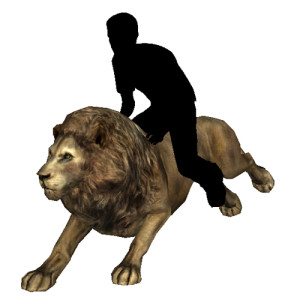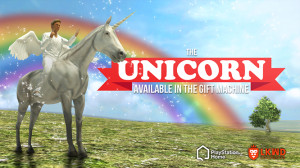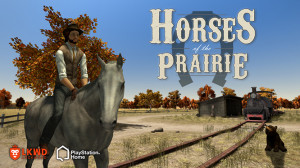World-Building and the Lockwood Horses
by SealWyf, HSM Editor
We’ve been edging toward horses in Home for a long time — horse statues, miniature horse-like companions (Demon War-Horse, anyone?), even small active-item ponies to set in your apartment. But the Holy Grail of horses, an actual ride-able steed, has only recently become possible, enabled by the extension of Home’s core code to include locomotions, which use the memory channel previously assigned to pets.
The first few locomotions were only new actions for the avatar body, such as custom dances and flying. These are grand additions — we had been requesting them for a long time. Then custom locomotions started to include additional items — skateboards and wings, bicycles and hover bikes. And then, at last, mounts — actual ride-able creatures.
Creating creatures takes some work. A skateboard doesn’t change when you ride it. But to be believable, a living creature needs additional animations. It’s a wonder they can fit into available memory at all, especially if there is a serious attempt at realism.
 The first animal mounts were simplified and cartoonish. But then Lockwood stepped into the picture, with Malaki the ride-able lion, which looked exactly like the life-sized lion companion. Creating a matching companion and mount took some chutzpah, since they were easy to compare. But Lockwood pulled it off. Maliki in either form looks like he just stepped out of a nature documentary.
The first animal mounts were simplified and cartoonish. But then Lockwood stepped into the picture, with Malaki the ride-able lion, which looked exactly like the life-sized lion companion. Creating a matching companion and mount took some chutzpah, since they were easy to compare. But Lockwood pulled it off. Maliki in either form looks like he just stepped out of a nature documentary.
A lion was one thing — programming a realistic horse must have been an order of magnitude harder. We don’t get up close and personal with many lions. But we know horses almost as well as we know dogs and people. If Lockwood got a horse wrong, we would recognize it. It would have been safer to start with a cartoon horse, perhaps a blown-up Stitchkins mount. But Home’s users wanted realism. And Lockwood pulled it off. And then, having cleared the hurdle, they returned and did a double back-flip over it, just to show they could.
Lockwood would have had a win on its hands if they had simply released realistic horse mounts. They could have sat back and collected profits. However, they have gone beyond, and given their horses a context.
This is what writers call world-building — the implication of a larger, surrounding world from a few carefully-rendered details. Even the name of the offering, “Horses of the Prairie”, implies much. First, it hints that there may be other collections of horses. Second, it creates a world in our minds, an image of an environment, which is reinforced by Lockwood’s PR text and graphics.
These are not generic horses. They are ponies and mustangs from a Western environment — a world of broad plains and scattered ranches, set either in the late 19th century or in a world that has not changed much since then. We are intimately familiar with this world — it’s populated by ranchers and cowboys, outlaws and marshals, Indians, settlers and dogged pioneers. With a few words and images, Lockwood has created an implied role-play for us, one we can enter by wearing the appropriate clothing. And, of course, by buying a horse.
I found it interesting that these are “naked” horses — the animal itself, without saddle, bridle or reins. Bareback riding is not unusual, but bridle-less riding definitely is. The lack of even a halter gives one pause.
However, it is not outside possibility. A well-trained horse can be controlled by the pressure of the rider’s legs. This is necessary for some working horses, where the rider’s hands are occupied. And “free riding” is a competitive event, as this video demonstrates:
Still, bridle-less riding is unusual. And we have to ask why Lockwood made this particular decision. My guest is that it was for technical reasons, having to do with memory management. Reins would require additional changes to the standard avatar animations. How would a riding avatar wave, for instance? Would they drop the reins? Pass them to their free hand? What about a two-handed “Over here!” emote? A shrug? Laughter? At some point it would become simpler to leave the reins off entirely. And, if the horse had no reins, it would probably not have a saddle. And so the horse was stripped bare.
But there is also a storytelling dimension to this decision. A horse without reins or saddle becomes a free and equal partner, an object of legend, like Gandalf and Shadowfax. This may not be realistic, but it is emotionally satisfying. It resonates with the idealised “horse stories” of childhood, beloved by little girls of my generation, in which horses could display great sensitivity and nearly human intelligence.
The storytelling and world-building extend to the public space Lockwood has created for the horses, which will be released at the same time. This space has several uses. First, it is a place to gallop, an outdoor space that is more appropriate to that activity than the Hub, the Casino, or the other largely indoor public spaces of Home. Few Home public spaces have much “space” at all — Sodium Hub and the attached Sodium Trainer spaces are the only ones that occur to me as being ideal for a gallop. So, Lockwood has obligingly supplied us with the prairie to which these horses belong.
The space also provides a motivation to buy the horses, if any more was needed. This is because you can’t get far into the space without a horse. And you are motivated to get into the space, because it is also a game where you can win rewards. You can’t win the rewards without playing the game, and you can’t play the game without buying a horse.
This is an absolutely brilliant marketing strategy. The horse becomes an element of gaming. And, because we get a horse out of it, I suspect that we will not really mind being strong-armed into the expense.
 Since this is Lockwood, there is also a Gift Machine component. And it’s a doozy. Because the giftable horse is a total must-have: a unicorn. I’m going to need to find someone to trade unicorns as quickly as possible.
Since this is Lockwood, there is also a Gift Machine component. And it’s a doozy. Because the giftable horse is a total must-have: a unicorn. I’m going to need to find someone to trade unicorns as quickly as possible.
At this point, the real question is “How many horses do we want?” All of them? But we also have to look ahead and ask what other breeds of horses might be following?
There are horses in places other than the plains of western North America. Horses are associated with high society, racing, fox-hunting, dressage, cavalry charges, knights, the circus, rodeos, hansom cabs and beer wagons. Dressage horses could include some very interesting prancing animations.
Which brings up the obvious question: how far might the animation of the horse extend? Would a jumper be possible? A bucking bronco? Would actual racing be a possibility? This question comes full circle, to my hopes for a stable game in Home, where we could train and race horses. I have not given up hope on that. After all, we already have aquariums.
The possibilities are huge. And they are largely bounded by the limits of the Home platform itself, and custom locomotions. It remains to be seen where all this will end. But for now we are delighted with what we have — realistic horse mounts and a space to ride them in. This is really a big deal in Home. And it doesn’t surprise me that it was Lockwood that finally pulled it off.



If Lockwood adds a Friesian to their herd, I’ll be one large bird of prey from recreating my very own personal Ladyhawke in Home.